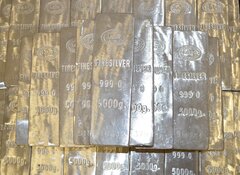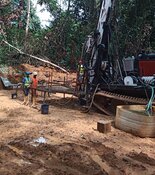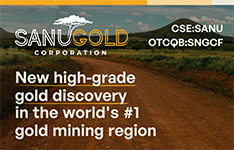The Gold Report: On April 15, gold dropped to a two-year low as panic selling set in across many mined commodities. Was this the larger players showing the retail market who is in control or was it inevitable?
Michael Gray: Several firms have been predicting a mid-cycle correction for gold; it just happened faster and with more volatility than expected. It also seems to be a very well-timed short-selling trade, especially on the back of the positive gold price correlation with quantitative easing (QE) breaking down and reversing post-QE3. In addition, there was no response in the gold price to the debt crisis in Cyprus or political concerns with North Korea. This was an opportunistic time for the shorts to come in, and they did, forcefully.
TGR: Does this indicate that investors prefer equities to gold?
MG: Not necessarily. The gold equities have moved sharply down and most are now pricing gold at an implied gold price of $1,000–1,200/ounce ($1,000–1,200/oz) or less. There is some fear that the gold bull run is over, which explains why many institutional investors have been abandoning their gold equity positions.
"We think the volatility in the gold market is ultimately good for the bull market."
TGR: Gold equities fell in lockstep with the fall in the gold price. Why?
MG: Gold equities have had an inverse correlation of share price: net asset value (P/NAV) versus the gold price since late 2009. Historically the senior gold equities have traded +1.2x P/NAV. Now we are looking at an average of 0.65x P/NAV among our senior gold producers. Essentially, investors are pricing in a much lower gold price on the forward curve.
As the gold price goes down, we believe investors will expect that the future gold price will drop as well. That is why the equities are trading in lockstep with the decline and have a much weaker response on the upside.
TGR: Has the drop in precious metals prices fundamentally changed the market?
MG: We have not seen this magnitude of volatility in this bull market up until now. It sets the stage for other big moves and for a more volatile market, perhaps including price upswings of similar magnitude. We think this volatility is ultimately good for the bull market.
TGR: Will it result in less gold being produced?
MG: The deferral of major capital projects and the number of projects that will be shelved because they cannot stand up to the stress test of a $1,200/oz gold price will limit growth among the senior companies. As that happens, we expect significantly less growth in the gold sector over the next five years if prices continue to lag or go sideways.
TGR: A JPMorgan Chase report dated April 16 said 10 years remain in the commodity supercycle and that the April 15 price drop was only a pause in the overall cycle. Do you agree, and what positives do you see as a result of the price drop?
MG: In general, we concur that this is a pause in the supercycle for metals in general, including base and bulk metals. China's growth being lower than expected shocked the market, at least in the short term.
The positives are that management teams are now less focused on growth and more focused on earnings and returns to shareholders—this could instill more investor confidence. It will take a few years, but having CEOs whose interests are more aligned with shareholders will impose more discipline among the producers.
TGR: In early April, Barrick Gold Corp. (ABX:TSX; ABX:NYSE) once again delayed development of its Pascua Lama gold project in Chile. What are the likely ripple effects for Barrick and the sector?
MG: This is one of those situations where a company believed it had earned its social license after a long dialogue with the government and various nongovernmental organizations (NGOs). Barrick likely felt it was crossing the finish line. Barrick is not alone in this situation.
"Management teams are now less focused on growth and more focused on earnings and returns to shareholders."
For the gold sector it means management teams will have to look at large capital expense (capex) projects through a lens that captures extreme capex creep risk, in the case of Pascua Lama from less than $3 billion ($3B) to north of $8B. Going forward, project scale and social license risk will be key issues—only the best projects will be built.
TGR: Is Chile still on your list of preferred mining jurisdictions?
MG: It was until recently. Canada, Mexico and the U.S. are at the top. Recent developments in Chile and elsewhere in South America with community relations and NGO protests are cause for concern.
TGR: If Mexico, Canada and the U.S. are your top jurisdictions, what is the next tier?
MG: The next tier would include Chile, Peru and Turkey. In particular, Turkey is embracing foreign investment, has attracted a significant amount of capital and has a successful track record of mines being permitted and put into production.
In South America, Brazil can be also be an attractive jurisdiction, depending on the state. In Central America, we like Nicaragua, where we cover B2Gold Corp. (BTO:TSX; BGLPF:OTCQX). Nicaragua has been very politically stable in the past decade and is one of the few countries in Central America that has a stable mining policy and royalty regime. In Africa, Namibia, Tanzania and Botswana would lead our list.
TGR: Let's look at management teams. Cash is king for junior mining equities right now, yet some junior mining executives are collecting big cash salaries. Some shareholders think the C-suite is overcompensated. What do you consider a reasonable salary for a junior mining CEO?
MG: Management compensation has been a blind spot for investors in the exploration sector during this bull market, given that many management teams have created tremendous value for shareholders. The compensation matrices among peer groups have been driven by market capitalization: The more you could grow your company, the more you could convince your compensation committee to pay you.
"When companies are deeply discounted and you can buy them at what seem to be fire sale prices, you will be rewarded down the line."
The problem is that juniors with undeveloped resources trading at $1B market caps in 2011 paid dearly to attract talent or retain talent. Their base salaries in some cases exceeded $400,000 ($400K) plus similar size annual cash bonuses. Now those same companies have market caps of $200–300 million ($200–300M), yet the compensation levels have not changed. The G&A burn rate related to these salaries is significant.
To evaluate compensation, we look at where the company is in the exploration cycle and how much skin management has in the game. The $80–150K/year salary range has the right ring for a very early-stage explorer with no assets of retained value. Companies that have more advanced assets probably need to pay in the $200–250K range, plus bonus.
TGR: How do people find out that information?
MG: It is all disclosed in the annual financial statements and in the Management Information Circular on www.SEDAR.com (System for Electronic Document Analysis and Retrieval).
TGR: A story in Canada's National Post reported that CEOs and company presidents are more often fired in good times than in tough times because expectations are higher. Does that apply in mining?
MG: That comes back to investors focusing on returns and punishing the senior mining companies for poor leadership, including overpaying to acquire assets and the inability to control operating and capital costs. In the gold space, three CEOs have been fired in relatively good times for focusing too much on growth. The trend is now toward CEOs trying to focus on earnings, provide realistic guidance and, if possible, pay a dividend. Those are the leaders who will keep their jobs.
TGR: A recent Macquarie research report said, "The producers will rapidly pursue M&A of new 'grade A discoveries' if they emerge but are unlikely to pursue the large, capex-intensive B- and C-quality discoveries. In the meantime, the price will get lower and favor the producers that are patient and seeking smaller, strategic tuck-in acquisitions." What is a tuck-in acquisition?
MG: I would like to start by making it clear that "rapidly pursuing 'grade A discoveries'" means that if a junior has found another Kupol or Eleonore deposit, the type of precious metal high grade/high margin deposits coveted by the seniors, it will garner a tremendous amount of attention and probably attract a takeover bid before a resource is defined. This is what happened with Virginia Gold Mines' Eleonore discovery, which is being developed by Goldcorp Inc. (G:TSX; GG:NYSE) in Québec and for which Virginia Mines Inc. (VGQ:TSX) holds a royalty.
That is what I mean by a rapid move on what are clearly high-grade/high-margin assets because they are so rare right now.
TGR: And now, what is a tuck-in acquisition?
MG: A tuck-in acquisition is one that the market views as a relatively small deal, say, under $500M. It either fills a gap in the producer's pipeline down the line, or is strategic in consolidating a district in which the producer is already active.
TGR: If Kupol and Eleonore were grade-A discoveries, what are examples of tuck-in acquisitions? Would it be something like Grayd Resource Corp. (GYD:TSX.V) and Agnico-Eagle Mines Ltd. (AEM:TSX; AEM:NYSE)?
MG: Yes, Grayd with Agnico in Mexico would qualify as a tuck-in acquisition. We would consider Goldcorp's purchase of Gold Eagle Mines Ltd. in the Red Lake Camp a tuck-in or bolt-on, albeit with a larger market cap. Extorre Gold Mines Ltd.'s acquisition by Yamana Gold Inc. (YRI:TSX; AUY:NYSE; YAU:LSE) was a relatively small acquisition but meaningful to Yamana's growth pipeline.
TGR: Are other juniors developing candidates for tuck-in acquisitions?
MG: In our coverage list, we have published our views on MAG Silver Corp. (MAG:TSX; MVG:NYSE) as a prime example for potential of consolidation of the 44% joint venture interest it has with Fresnillo Plc (FRES:LSE) in the world-class Fresnillo Silver Trend. It is a high-grade, high-margin asset that we think Fresnillo would like to control. It would also help meet Fresnillo's goal for production of at least 65 million ounces (65 Moz) by 2018.
TGR: How close is MAG Silver's Juanicipio to Fresnillo's operations?
MG: It is within 1 kilometer of the mill and infrastructure, right in the heart of the Fresnillo district. In our view, as published in our research, it has great synergies with Fresnillo's existing operations..
TGR: Would Fresnillo buy just Juanicipio or buy MAG Silver outright?
MG: Fresnillo owns a 17% interest in MAG Silver. Given the fairly significant discovery MAG Silver has made on an asset called Cinco de Mayo, we would expect that Fresnillo would want that as well.
TGR: Regardless of a takeover bid, is MAG Silver poised to perform in 2013 even with lower silver prices?
MG: The company will break ground in the next month or two for the decline at Juanicipio. But the real sizzle for MAG Silver is getting back to exploration drilling at Cinco de Mayo, probably in H2/13.
Cinco de Mayo is a huge carbonate replacement deposit (CRD), a silver-zinc-lead deposit with an early resource estimate just over 50 Moz silver. It has a large footprint and an outstanding intersection at depth outside of the resource of 61.6 meters at 89 grams/tonne (89 g/t) silver, 7.4% zinc, 2.1% lead and 0.78 g/t gold. This is one of the best discoveries in Mexico in the cycle. Although early stage and the exploration to depth needs a lot of infill drilling, the anatomy of the system discovered so far suggests it could be very large.
TGR: Does MAG Silver have the disciplined management team you like to see?
MG: Yes, the team performs its discovery role exceptionally well. To make two major discoveries over the past decade is impressive in itself, but it is also very disciplined. It maintained a very efficient capital structure, with fewer than 60M shares issued and outstanding. It has discovered best-of-breed assets with what we would consider best-of-breed talent.
TGR: Which other juniors are developing possible tuck-in acquisitions?
MG: In that category, we like Midas Gold Corp. (MAX:TSX). The company's Golden Meadows project in Idaho has more than 7 Moz gold in resources and a significant antimony credit. The company has issued a preliminary economic assessment (PEA) on the project. It is only trading with a market capitalization of $100M or so.
This would be an excellent tuck-in acquisition for producers looking for a +400,000 oz/year production profile, starting in 2018 or 2019.
We see Midas' Golden Meadows project as a Donlin Creek-type of setting, and published our belief that the potential endowment could ultimately exceed 20 Moz gold. Thus, in our view it is potentially a Tier 1 asset that already has 7 Moz documented, in a historic mining district, making it a brownfield site. The company is heavily discounted in value right now.
TGR: What progress has Midas made since you started covering it 18 months ago?
MG: The company has executed well the mandate to infill and expand the near-pit resources and establish resources that could be put into a PEA and eventually into a preliminary feasibility study. It has also conducted a lot of pragmatic consulting with the community and the NGOs.
Stephen Quin, Midas' CEO, has the perfect skill set for permitting and advancing the economics of this project given his past experience with similar projects.
The overhang is the perception that it will be tough to permit in Idaho and that production is a long way out in 2018. As a result, the stock has lagged over the last 12 months.
TGR: How much does the antimony credit play in the project economics?
MG: At the front end, the antimony credit is fairly important. I believe about 80% of the antimony currently documented will be produced in the first four years. This allows Midas to achieve gold equivalent grades that exceed 2.4 g/t, whereas the average grade in the first pit to be mined is closer to 2.0 g/t for the gold only. Therefore, the antimony credit is fairly important.
During World War II, Golden Meadows was mined for antimony needed to harden shell casings. Now antimony is used mainly as a fire retardant. About a year ago, antimony led the British Geological Survey list as the #1 commodity at risk. That is a compelling twist to the Midas story.
TGR: Where does permitting stand?
MG: The formal permitting process is called the Joint Review Process (JRP), which harmonizes the review activities of the state and federal governments. This process has not started yet; however, because Midas has completed a PEA study, it is able to start the informal process right now and consult with various stakeholders. We expect Midas may be in a position toward the end of 2013 to formally enter the JRP.
On a separate front, it is unfortunate that the U.S. Forest Service pulled back some of its drill permits on non-patented lands. Having to re-apply for those will delay exploration on the outer reaches of the property. There is no question that permitting in Idaho can take time, but in our view it is a question of when, not if, providing responsible plans are put forward and the process is closely adhered to.
We believe management has the right skill set to persist and earn the social license to permit Golden Meadows. This is a state with high unemployment and mining the brownfield site would actually clean it up. It is a good news story.
TGR: To value companies, you use a sum-of-parts NAV valuation system based on a 5% discounted cash-flow model. Using this system, what companies are among your top picks?
MG: We also use the forward curve and long-term commodity prices to value the companies where we are able to establish a discounted cash-flow model. When we see this much market volatility in the commodity prices, we tend to make more frequent adjustments to the forward curve we are using and to reset target prices accordingly.
MAG Silver, Mirasol Resources Ltd. (MRZ:TSX.V), B2Gold and Tahoe Resources Inc. (THO:TSX; TAHO:NYSE) are our top picks among the companies we cover.
Mirasol Resources is a cash-rich junior that has emerged in a very strong position through discovery and monetizing its assets. We estimate it has approximately $50M in cash and investments.
We like Mirasol because it has shifted its exploration focus to Chile and has identified what appears to be a large, high-sulphidation system. If Mirasol succeeds, this potentially large gold system will attract the seniors' interest. The project is very early and only trenched so far—we expect drilling in May and June—but the markers suggest that Mirasol could be onto a fairly significant new belt in Chile.
The company also has significant assets in Argentina, although they do not yet have resources.
TGR: Is there less pressure in Chile on smaller companies?
MG: As long as their programs are not huge, smaller companies are likely better able to fly under the radar. In the early stages, they do not have to negotiate for water rights or consult with the communities on a formal basis. That makes it easier.
At the same time, they have to pave the way for the ultimate developers to earn their social licenses. It is important that they execute on the ground at an extremely early stage by developing good relationships and respecting the community.
TGR: Access to water is one of the biggest issues in Chile. Does Mirasol have a clear path to water?
MG: The company has been somewhat cryptic as to the exact project location and has yet to conduct an analyst site visit. Our understanding is that Mirasol is still acquiring strategic land positions within this new belt.
TGR: When will that information be available?
MG: We are confident in the management team's ability to conduct generative research using satellite and Advanced Spaceborne Thermal Emission and Reflection Radiometer (ASTER) imagery to identify large alteration signatures. The company has homed in on a specific area with nine targets. As it goes forward to drill the initial targets in the next few months, I expect more visibility on the actual location and setting.
TGR: What other companies are on your top pick list?
MG: B2Gold is one. For an intermediate producer, B2Gold has a top management team. The company is a hybrid producer-explorer, and it does both well. It operates gold mines in Nicaragua, a new acquisition in the Philippines called the Masbate mine and a development project in Namibia. The company has a tremendous growth profile: from 150,000 oz (150 Koz) last year to what we estimate could exceed 500 Koz by 2015. It all comes at a fairly low capital expense.
B2Gold also comes with tremendous exploration upside. In Nicaragua, it is executing a feed-the-mill strategy to extend mine life. By exploring the La Libertad gold belt and finding satellite deposits at twice the grade, it is able to feed its mill and grow organically. For example, we estimate that the Jabali satellite deposit will generate a 95% internal rate of return.
B2Gold acquired Auryx Gold Corp. in December 2011. It did not overpay for an asset that will deliver 140 Koz/year by 2015, along with a tremendous exploration belt. This is the former Bema Gold team that discovered Refugio, Cerro Casale and created tremendous value at Kupol; Kinross Gold Corp. (K:TSX; KGC;NYSE) subsequently bought Bema for $3.6B.
TGR: One of the more interesting projects in B2Gold's portfolio is the Gramalote joint venture in Colombia. What can you tell us about that project?
MG: Gramalote is a strategic gold porphyry development project in Colombia and is operated by AngloGold Ashanti Ltd. (AU:NYSE; ANG:JSE; AGG:ASX; AGD:LSE). It is a 51/49 joint venture, 51 for AngloGold Ashanti.
Gramalote is somewhat low grade—0.65 g/t average grade—and would be a milling operation. It has good infrastructure and very good recoveries. The project is in the midst of a preliminary feasibility study, and we expect better visibility on the economics in the next few months. In our view, it is probably of less strategic interest to B2Gold, given the location and the probable high cost to build the project.
However, in our view, Gramalote is very strategic to AngloGold Ashanti as development of this asset to production could pave the way for a separate 100%-owned project called La Colosa in a different part of Colombia that is reportedly in the 25+ Moz gold resource size. La Colosa is the ultimate prize in Colombia for AngloGold Ashanti.
TGR: Can B2Gold achieve significant production increases at La Libertad and Masbate?
MG: Yes. Masbate brings in the range of 180–200 Koz to B2Gold. It has not decided on an expansion, but we model a +50 Koz/year expansion in 2015. This becomes the flagship asset for B2Gold with its contribution to production and growth.
At La Libertad, we see incremental production growth through 2013–2014, topping out near 150 Koz.
TGR: Do you have another top pick that you would like to talk about?
MG: Tahoe Resources has a best-of-breed silver asset in Guatemala and is run by Kevin McArthur, former CEO of Goldcorp and Glamis Gold Ltd., along with his very strong team. Tahoe has built an underground mine for less than $400M, on time and on budget. It should be completed by July 2013.
What stands out about Tahoe's Escobal mine development project is its high grade and large size. It has more than 400 Moz in silver resources and will mine average grades of 400 g/t, with some gold, zinc and lead credits. Another key is that the veins are very thick, averaging 10–15m in one zone, and over 15m in another. The company can, therefore, mine very efficiently and run the plant initially at 3,500 tons per day (3,500 tpd), moving up to 5,000 tpd and potentially to 7,000 tpd. You are looking at 20 Moz/year silver for at least the first eight years.
TGR: That is an interesting point about scalability in projects, something offered by very few projects.
MG: This is an asset built by a veteran team that contemplates that upside. The incremental expansion is more or less designed and factored in to get to 5,000 tpd.
TGR: Kevin McArthur was on Canada's BNN, and he was grilled about some problems with the locals near its project after an incident. Is that a problem?
MG: It is an ongoing issue. The company received its permit—a real endorsement from the government—and a government presence on-site helps with security.
This is a change to the local economy. It is an industrial site near the town of San Rafael, a community that we estimate will benefit from the new royalty regime to the tune of about $10M/year. Communities farther away also will feel the impact.
Guatemala does not have a mining culture with a long history. There will be community relations and security issues to manage in the near and medium term.
TGR: According to your models, what sort of cash flow will Tahoe generate by Q4/13?
MG: We show Tahoe being cash flow positive in Q4/13 and overall guidance of 5 Moz silver being produced into 2013. Looking out to 2014, and using a forward curve from Feb. 6, 2013, and a higher silver price ($32/oz silver), we are looking at $353M cash flow from operations in 2014 for $2.33/share.
Another attraction with Tahoe is that management suggested last summer that it would pay a significant dividend.
TGR: If you were a grief counselor for retail investors with positions in gold, how would you assuage them after the recent dramatic market events?
MG: Being one of those investors who feel the pain, I can empathize. It comes back to volatility. If you are convinced that the best companies will come out of this, when they are deeply discounted and you can buy them at what seem to be fire sale prices, you will be rewarded down the line. It also comes back to the potential swings in volatility we could see to the upside. That is why you want exposure to the gold sector, especially in equities, despite its downtrodden reputation.
TGR: Thank you for your insights.
Michael Gray is a mining equity analyst with Macquarie Capital Markets and covers a range of precious metal explorers and producers with an emphasis on North and South America. He is an exploration geologist and holds a Bachelor of Science in geology from University of British Columbia and Master of Science in economic geology from Laurentian University. His career of over 25 years in the mineral exploration business started with senior mining companies including Falconbridge, Lac Minerals, Cominco and Minnova where he worked throughout Canada and the USA. He co-founded Rubicon Minerals in 1996 and helped navigate the company through a series of joint ventures and an asset portfolio build that was eventually centered on the Red Lake gold district in Canada. During this period, Gray was president of the 5,000 member British Columbia and Yukon Chamber of Mines for one year and on the executive committee for six years. Gray then joined the mining analyst world in 2005 where he brought to bear his technical skills to identify new precious metal opportunities at an early stage with outstanding exploration potential; he has covered a number of these opportunities that were subsequently taken over by gold producers.
Want to read more Gold Report interviews like this? Sign up for our free e-newsletter, and you'll learn when new articles have been published. To see a list of recent interviews with industry analysts and commentators, visit our Streetwise Interviews page.
DISCLOSURE:
1) Brian Sylvester conducted this interview for The Gold Report and provides services to The Gold Report as an independent contractor. He or his family own shares of the following companies mentioned in this interview: None.
2) The following companies mentioned in the interview are sponsors of The Gold Report: B2Gold Corp., Goldcorp Inc., MAG Silver Corp. and Tahoe Resources Inc. Streetwise Reports does not accept stock in exchange for its services or as sponsorship payment.
3) Michael Gray: I or my family own shares of the following companies mentioned in this interview: Goldcorp Inc. and Barrick Gold Corp. I personally or my family am paid by the following companies mentioned in this interview: None. Macquarie Capital Markets disclosures are available here. I was not paid by Streetwise Reports for participating in this interview. Comments and opinions expressed are my own comments and opinions. I had the opportunity to review the interview for accuracy as of the date of the interview and am responsible for the content of the interview.
4) Interviews are edited for clarity. Streetwise Reports does not make editorial comments or change experts' statements without their consent.
5) The interview does not constitute investment advice. Each reader is encouraged to consult with his or her individual financial professional and any action a reader takes as a result of information presented here is his or her own responsibility. By opening this page, each reader accepts and agrees to Streetwise Reports' terms of use and full legal disclaimer.
6) From time to time, Streetwise Reports LLC and its directors, officers, employees or members of their families, as well as persons interviewed for articles and interviews on the site, may have a long or short position in securities mentioned and may make purchases and/or sales of those securities in the open market or otherwise.









































